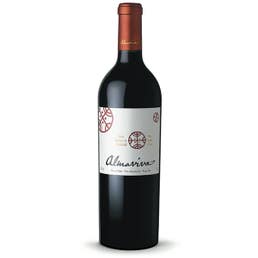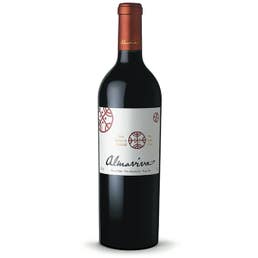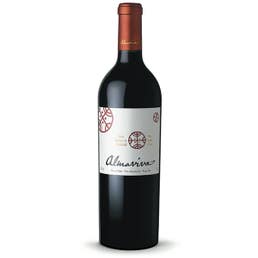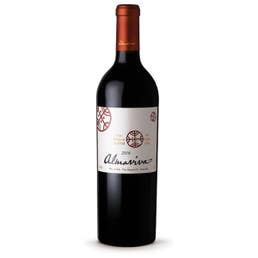Vina Almaviva 2017
• Domaine: Vina Almaviva
• Appellation: Maipo Valley, Wine of Chile
• Classification: Maipo Valley, Puente Alto, Chile
Almaviva is a premium wine produced in Chile's Maipo Valley, one of the country's most renowned wine regions. The wine is a joint venture between the French owner of Château Mouton Rothschild, Baroness Philippine de Rothschild, and Chile's Concha y Toro. The first vintage of Almaviva was produced in 1996. Even though the Baroness passed away on August 23, 2014, her three children continue investing in this project, which has since gained a reputation as one of Chile's finest wines.
Almaviva is a blend of classic Bordeaux grape varieties, including Cabernet Sauvignon, Carmenere, Cabernet Franc, Merlot, and Petit Verdot. The wine is aged in French oak barrels for around 18 months before bottling. The resulting wine is rich, complex, and elegant, with a deep ruby color and aromas of black fruits, spices, and vanilla.
Almaviva is considered a wine for special occasions and is highly sought after by collectors and connoisseurs. The wine has received numerous awards and accolades, including a 100-point rating from the influential wine critic Robert Parker.
HISTORY
In 1997, Baroness Philippine de Rothschild, owner of Mouton Rothschild, and Eduardo Guilisasti Tagle, owner of Viña Concha y Toro, entered into a partnership to create an exceptional Franco-Chilean wine called Almaviva.
The name Almaviva has a Hispanic sonority. It actually belongs to classical French literature: Count Almaviva is the hero of The Marriage of Figaro, the famous play by Beaumarchais (1732-1799), later turned into an opera by the genius of Mozart. The label bearing the name Almaviva is in Beaumarchais’ own handwriting.
Though not claimed by the owners, the referral to a play reminds a curiously minded observer of the successful theatrical career left behind by the Baroness Philippine de Rothschild to assume leadership at her father's business when he died. Her stewardship of the venerable Bordeaux estate plus her success in breaking new grounds led her to be made an Officier of the Légion d'Honneur in 2007. In 2013, she was given a lifetime achievement award by the Institute of Masters of Wine.
Almaviva was intentionally chosen to pay homage to Chile’s ancestral history, with three reproductions of a stylized design, which symbolizes the vision of the earth and the cosmos in the Mapuche civilization. The design appears on the kultrun, a ritual drum used by the Mapuche. Two great traditions thus join hands to offer the whole world a promise of pleasure and excellence.
Tasting Notes
"A Cabernet Sauvignon mixed with 23% Carménère, 5% Cabernet Franc, 5% Petit Verdot and 2% Merlot from Puente Alto, Maipo that spent 19 months in French barrels. Reflecting a warm, dry year, the nose presents notes of black currant and raspberry jam, black tea leaves and sweet spices with a touch of kirsch. Gentle on the palate with firm, pleasant tannins, a loose structure, bold flavor and intriguing expression. A hint of menthol makes itself felt at the back of the mouth." - Joaquin Hidalgo, vinous.com, (March,2020), Rating: 94, Drink:2020-2035
"2017 was an unusual year, warm and extremely dry (178 liters of rain, but there was some rain after the 2016 harvest, so the soil had some water), and the harvest and the whole cycle was two to three weeks earlier than normal. That is the context for the 2017 Almaviva, whose vines saw extremely low yields (ten hectoliters per hectare in the older parts, 36 hectoliters per hectare in the young vines) and produced concentrated juice. The bottled blend is 65% Cabernet Sauvignon, 23% Carmenère, 5% Cabernet Franc, 5% Petit Verdot and 2% Merlot, quite similar to the 2016, and the alcohol level reached 14.6% with a pH of 3.65 and 4.9 grams of acidity (measured in tartaric acid). It matured in French oak barriques (825 of them new) for 19 months. It's a riper, rounder and softer vintage, with moderate acidity and a tender mouthfeel, really marked by very high temperatures all year round. They used a little more Petit Verdot in the blend, but there is no overripeness. The wine shows some herbal aromas (I really notice the touch of the Carmenere this year). They harvested extremely early (three weeks earlier than normal!) and were able to keep the tension in the wine, and it has a polished mouthfeel and very round tannins. It's a nicely crafted red blend, and they were able to overcome the difficulties of the year; I see the style of something between 2016 and 2015, quite compact. It might require some more bottle age to open up, and it should develop nicely in bottle. 180,000 bottles produced. It was bottled in January 2019." - Luis Gutiérrez, Robert Parker's Wine Advocate (8/30/2019), Ratings: 94+, Drink: 2020-2032
"A glorious and complex nose of tobacco and blackberry with hints of stone, flowers and bitter chocolate. Full-bodied, very tight and compacted. Linear backbone gives this form and tension. It has the same character on the palate, as well as cayenne and other spices. Loved the 2014 but this shows more fine-grained tannins. So balanced and harmonious. A blend of 69% cabernet sauvignon, 24% carménère, 5% cabernet franc and 2% petit verdot. Needs four or five years in the bottle but a joy to taste now." - James Suckling, Rating: 100
| LWIN | 1083246 |
|---|---|
| Stock Status | Out of Stock |
| Appellation | Maipo Valley |
| Vintage | 2017 |
| Brand | Viña Almaviva |
| Shipping Weight | 3.000000 |







